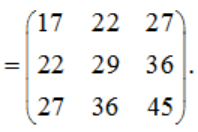I have matrix. Here this
create table matr1
(
x1 num,
x2 num,
x3 num,
x4 num,
x5 num,
x6 num,
x7 num
)
insert into comm values
(1,0,0,0,0,0,0,0),
(1,0,5,1,2,2,8,0,0,5,0,2),
(1,0,5,0,0,0,1,2,0),
(1,0,0,0,0,0,0,0),
(1,0,0,5,0,8,0,0,0,2),
(1,0,0,0,2,0,1,2,-12),
(1,0,5,0,5,0,1,0,-10,14),
(1,0,5,0,0,5,-1,0,10,-12),
(1,1,0,0,5,1,0,-10,13),
(1,-0,5,0,0,5,0,2,14,1),
(1,1,0,-0,5,-1,0,0,0),
(1,-0,5,0,0,0,5,-1,0,0),
(1,0,0,0,5,0,1,1,2),
(1,1,0,-0,5,-0,5,1,2,-2),
(1,0,0,0,7,0,5,-1,5,-3,8),
(1,-4,-2,-3,7,-1,5,4,5,8,4),
(1,0,1,2,0,1,2,-14),
(1,0,5,0,5,0,1,-1,-12,0),
(1,1,0,0,-1,0,5,0,0),
(1,0,0,5,1,5,0,1,5,0,0),
(1,0,5,0,0,5,0,0,0,20),
(1,0,2,5,0,-1,4,22,2),
(1,-2,-1,0,1,0,0,-4),
(1,0,5,0,5,0,1,-2,-4,10),
(1,0,-3,-2,5,-2,5,6,8,0),
(1,0,0,0,0,0,0);
then i have this matrix but it only transposed.
here it
create table matr2
(
x1 num,
x2 num,
x3 num,
x4 num,
x5 num,
x6 num,
x7 num,
x8 num,
x9 num,
x10 num,
x11 num,
x12 num,
x13 num,
x14 num,
x15 num,
x16 num,
x17 num,
x18 num,
x18 num,
x19 num,
x20 num,
x21 num,
x22 num,
x23 num,
x24 num,
x25 num,
x26 num
)
(1,1,1,1,1,1,1,1,1,1,1,1,1,1,1,1,1,1,1,1,1,1,1,1,1,1),
(0,0,5,0,5,0,0,0,0,5,0,5,1,-0,5,1,-0,5,0,1,0,-4,0,0,5,1,0,0,5,0,-2,0,5,0,0),
(0,1,2,0,0,0,5,0,0,5,0,0,0,0,0,0,0,0,-2,1,0,5,0,0,5,0,2,5,-1,0,5,-3,0),
(0,2,8,0,0,0,8,0,2,0,0,5,0,5,0,5,-0,5,0,0,5,-0,5,0,7,-3,7,2,0,0,1,5,0,5,0,0,0,-2,5,0),
(0,0,0,0,0,0,1,-1,1,0,-1,0,5,0,-0,5,0,5,-1,5,0,1,-1,0,0,-1,1,1,-2,5,0),
(0,0,5,1,0,0,1,0,0,0,2,0,-1,1,1,-1,5,4,5,1,-1,0,5,1,5,0,4,0,-2,6,0),
(0,0,2,0,0,2,-10,10,-10,14,0,0,1,2,-3,8,2,-12,0,0,0,22,0,-4,8,0),
(0,0,2,0,0,2,-12,14,-12,13,1,0,0,2,-2,8,4,-14,0,0,0,20,2,-4,10,0);
how to multiply the first matrix by itself but transposed ?
that result must be something like in the picture

Can anybody help please?

